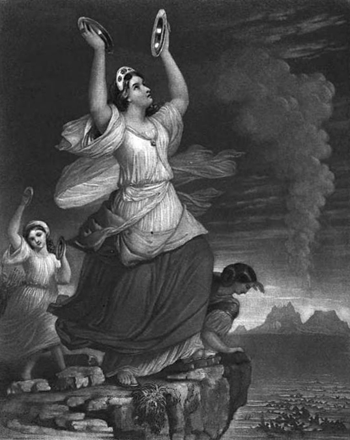There’s no doubt that ancient
society was very patriarchal and often rather sexist. Men made the laws and
ruled over women, who were most often valued for how fertile their wombs are. So
how is it that in the literature of this kind of society, women manage to
appear in the spotlight? No matter how strange it may seem to us in context,
this happens quite often in the Old Testament.
In
fact, there are 188—133 in the Old Testament alone (4)—named women in the
Bible, and many others whose names we do not know. While many of these women,
such as Sarah and Rachel, seem most concerned about having children and fit the
stereotype of women from this time, others appear in roles in which we would
never expect to see a pre-modern woman. Women in the Bible serve as
prophetesses, Judges, and even generals (1).
Like the
male figures in the Bible, many of these women are far from perfect, and are
depicted in a realistic way. The text doesn’t try to shield us from their flaws
and present them as the classic “perfect wife” depicted in Proverbs 31. Rahab,
a prostitute, helps the Jewish people conquer Jericho (2). Ruth, a childless
woman—and a foreigner at that—was hailed for her loyalty and valor long before
she was remarried, and she has an entire book of the Bible dedicated to her (3).
Deborah is both a Judge and a general, as well as one of the greatest Hebrew
leaders after the death of Moses.
This
frequent depiction of women in key roles in society leads me to ask: why? Why would a culture so infamous for
degrading women bother to exalt them? Well, it turns out that—compared to their
contemporaries—the Israelites really weren’t that degrading towards their women.
For example, Pagan religions—which we often hail today as being
gender-inclusive because they often have central goddesses—really weren’t as
respectful of women as we sometimes think. Sure, women were allowed to serve as
priestesses—something forbidden to most Israelite women—but “priestess” really
meant “temple prostitute. In fact, almost every time that a Christianity or
Judaism becomes prevalent in a new area, the status of women is raised (6). This
trend would continue throughout most of history, and women would eventually
gain many rights in the name of Christianity. This is likely due to the Bible’s
strong belief in the inherent human dignity of all persons.
While
the Bible is by no means entirely devoid of sexism, it helps to lay the
primitive foundations for gender equality by hailing women as heroes as well as
men. It presents these women, not as shallow vessels for bearing children, but
as individuals, which is a pretty amazing thing considering the time period.
(6)
http://www.gty.org/resources/articles/A265/the-biblical-portrait-of-women-setting-the-record-straight
